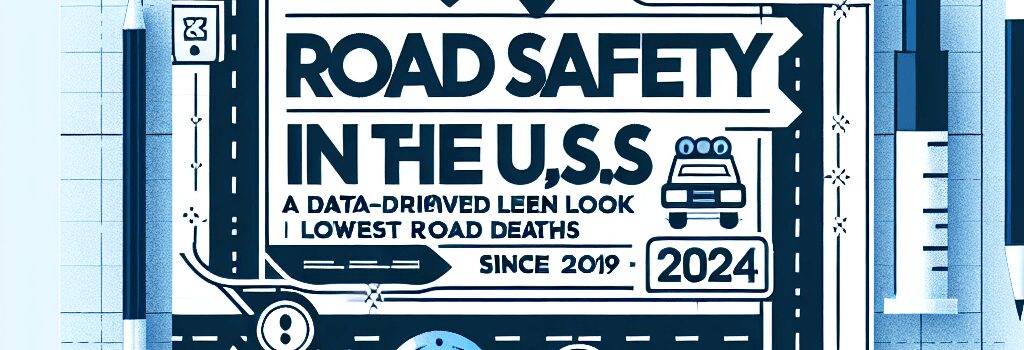Road Safety in the U.S.: A Data-Driven Look at 2024’s Lowest Road Deaths Since 2019

For the second consecutive year, U.S. roads have become marginally safer. The National Highway Traffic Safety Administration (NHTSA) has released early estimates for 2024 showing that 39,345 people lost their lives, a 3.8% decrease compared to 40,901 fatalities in 2023. While this drop represents positive progress, experts stress that the current figures still translate to too many preventable losses and underscore the continuous need for improved traffic safety measures.
Overview of 2024 Road Safety Improvements
The reduction in fatalities in 2024 comes on the heels of significant changes introduced during and after the pandemic. Although the initial lockdowns led to unusually empty roads, the subsequent behavioral shifts and relaxed enforcement spurred an increase in speeding and risky driving practices. The current downturn can be attributed to intensified safety protocols, renewed public awareness, and incremental enhancements in road infrastructure and vehicle safety systems.
Technological Innovations Enhancing Road Safety
One of the key factors in this trend has been the infusion of modern technology into both vehicle systems and traffic management solutions. Recent advancements include:
- Advanced Driver Assistance Systems (ADAS): Implementation of systems such as automatic emergency braking, lane departure warnings, and adaptive cruise control have contributed to mitigating human error during critical moments.
- Sensor Integration and Connected Infrastructure: Enhanced traffic management utilizes a network of sensors, including radar, LiDAR, and high-definition cameras, which relay real-time data to centralized control systems. These systems, often powered by AI and machine learning algorithms, enable predictive analytics that help in preventing accidents before they occur.
- Vehicle-to-Everything (V2X) Communication: Modern vehicles benefit from interconnectivity with other cars and road infrastructure. This communication framework supports quicker response times during emergencies, thereby reducing the risk of collision-related fatalities.
Automotive experts note that while these technologies are a major boon for road safety, their full potential relies on robust data analytics supported by edge computing and cloud-based processing environments. Continuous updates to these systems, informed by ongoing research and real-world data, promise further improvements in driver safety and road performance.
Regional Disparities and Policy Implications
Despite nationwide improvements, several states and the District of Columbia experienced increased fatalities in 2024. In fourteen states, road deaths have either stagnated or risen, often in spite of high-profile initiatives such as the “Vision Zero” programs. These initiatives, which aim to eliminate traffic deaths entirely, encounter challenges including:
- Enforcement Gaps: Many jurisdictions suffer from inconsistent enforcement of traffic laws, leading to a perception of lax enforcement which encourages speeding and other risky behaviors.
- Design Flaws in Vehicle Architecture: The increasing trend toward larger trucks and SUVs—with designs that include higher hoods—has drawn criticism from safety advocates. These vehicles, while popular among consumers, pose greater risks in collisions, especially to pedestrians and cyclists.
- Infrastructure Limitations: Some regions have not fully integrated modern traffic management technologies, leaving them more vulnerable to preventable accidents.
Policymakers and urban planners are now pushing for a greater integration of technical solutions with traditional traffic law enforcement to close these gaps. Although progress is evident in major metropolitan areas, regional disparities remain a major challenge for nationwide road safety.
Advanced Vehicle Technologies and Their Impact
Automakers are increasingly investing in advanced technologies that not only enhance driving convenience but also improve safety. Features such as sensor fusion—which combines data from multiple sources—help in creating a comprehensive situational awareness for collision avoidance. In addition, innovations in vehicle software architecture now allow for over-the-air updates that can refine safety algorithms based on aggregated driving data. These technologies, coupled with rigorous crash testing and simulation analysis, are expected to lead to safer car designs and lower road fatality rates in years to come.
Future Outlook: AI, Data Analytics, and Road Safety
Looking forward, the integration of AI and advanced data analytics into traffic management and vehicle design is expected to drive further reductions in road fatalities. Researchers are exploring:
- Predictive Analytics: Utilizing big data to foresee high-risk conditions or areas where accidents are likely to occur, thereby allowing preemptive interventions.
- Machine Learning Algorithms: Leveraging historical accident data to refine autonomous vehicle algorithms, improving their decision-making process during emergencies.
- Cloud and Edge Computing: These technologies provide the computational power required to analyze real-time data from diverse sources, ensuring rapid responses to unforeseen hazards.
Experts predict that these advancements will not only help in maintaining the downward trend in fatalities but also in adapting road safety measures to emerging challenges. While 2019 remains one of the safest benchmarks, continued investment in technology and smarter policies is critical to achieving long-term reductions in road deaths.
Conclusion
Although the reduction to 39,345 road fatalities in 2024 marks an encouraging milestone, the journey toward significantly safer roads is far from over. A combined effort from government bodies, automotive manufacturers, and technology firms is essential to maintain and expand upon these gains. As AI, cloud computing, and integrated vehicle technologies evolve, the potential to further decrease road deaths becomes more tangible—bringing us closer to a future where safe travel is a standard, not an aspiration.